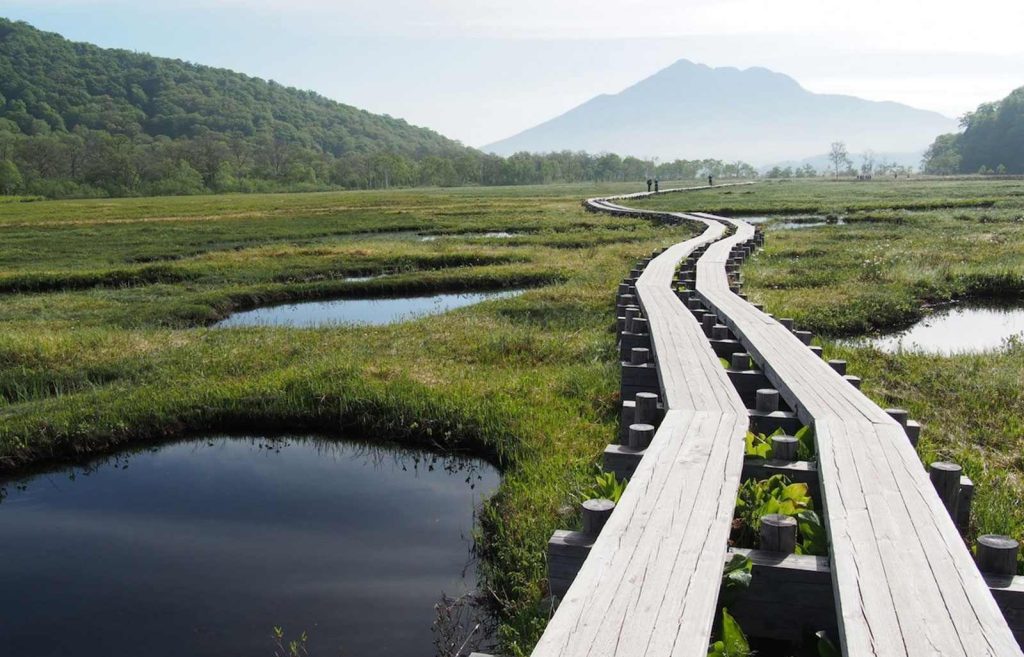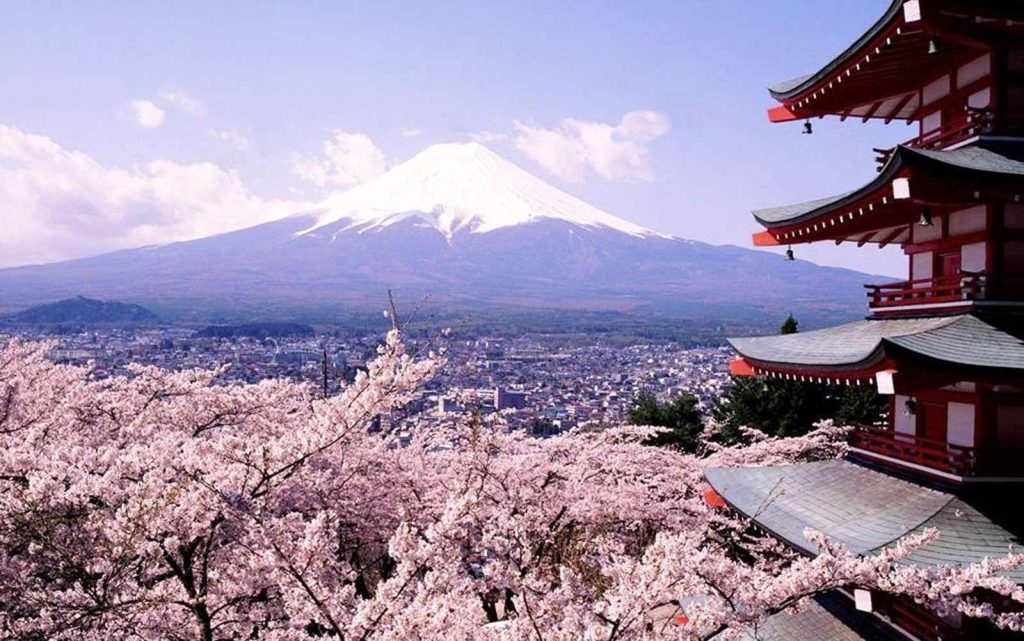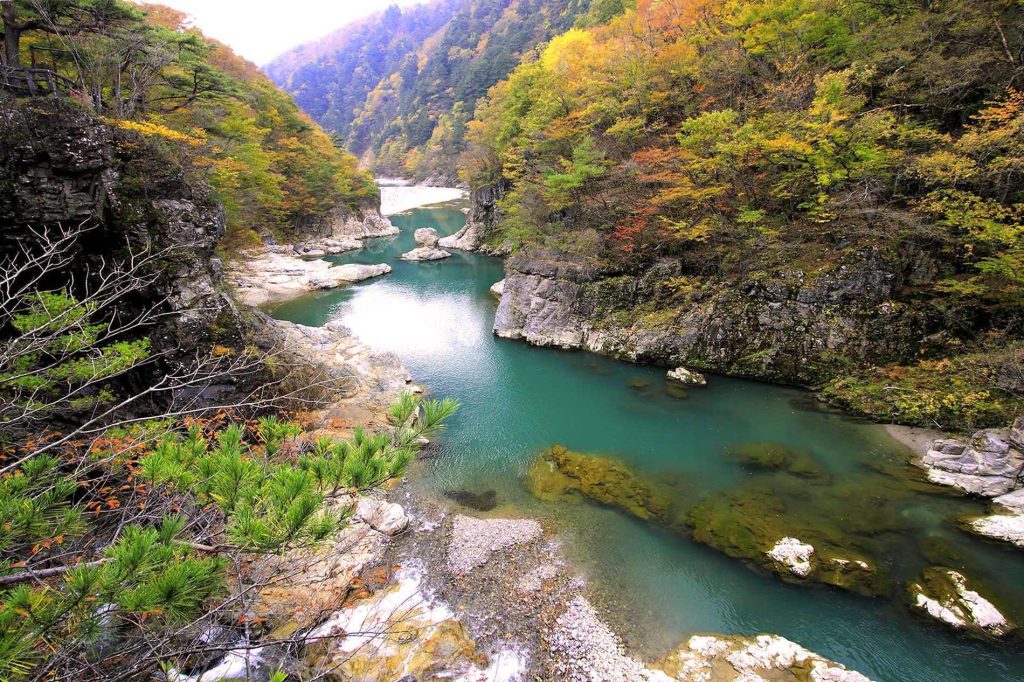The Oze National Park (in Japanese: 尾瀬国立公園 Oze kokuritsukōen) is one of the most remarkable destinations for nature lovers in Japan. With unparalleled landscapes, rich biodiversity, and hiking trails for all levels, Oze offers a unique experience. Throughout the year, the park changes dramatically, allowing visitors to discover different aspects of this natural environment. In this article, we invite you to learn about the secrets of Oze, its flora and fauna, and the best activities to enjoy during your visit.
Content
Oze National Park Information
History
Oze National Park, established on August 30, 2007, spans four prefectures: Fukushima, Tochigi, Gunma, and Niigata. Previously part of Nikko National Park, Oze was designated as a national park due to its unique ecology and towering landscapes. Upon its establishment, 25,203 hectares of the Oze area, which currently constitute 67.75% of the park, were separated from Nikko National Park. Additionally, surrounding areas such as Aizu-Komagatake, Mount Tashiroyama, and Mount Taishaku were incorporated. With a total area of 37,222 hectares, Oze is the 29th national park and the first in 20 years since Kushiro Marsh National Park, forming part of the network of Japanese national parks.
Location
Located about three hours north of Tokyo, Oze stretches across several prefectures, including Gunma, Fukushima, Tochigi, and Niigata. Although its access may seem remote, visitors can easily reach the park by public transport or car, making it a popular destination for both local hikers and international tourists.
Best Time to Visit Oze
The best time to visit Oze depends on the type of landscape you wish to enjoy. In spring, Mizubasho flowers cover the wetlands, while in summer, the park is filled with lush greenery. In autumn, the warm colors of the trees transform the park into a picturesque scene, making it one of the preferred times for photographers.
How to Get to Oze National Park
From Tokyo
To reach Oze National Park from Tokyo, the most common way is to take the train from Ueno or Tokyo Station to Numata Station on the JR Joetsu Line. The train ride takes about two hours. From Numata, you can take a bus that goes to the park entrance, with an additional travel time of one and a half hours. It is advisable to check the bus schedules, as the frequency may vary depending on the season.
From Maebashi
From Maebashi, the capital of Gunma Prefecture, access to Oze National Park is relatively straightforward. You can take a train on the JR Ryomo Line to Numata Station, with a journey time of approximately 50 minutes. From Numata, visitors can take the same bus that departs for the park entrance. This route is a convenient option for those already in the Gunma region.
Getting Around the National Park
Oze National Park is primarily a hiking area, so the main mode of transport is walking. There is no vehicle access within the park, and most of the trails are well-marked with wooden walkways to preserve the ecosystem. Information points at the park’s main entrances provide maps of the hiking routes. For those planning longer hikes, mountain lodges are available, though it is recommended to make reservations in advance.
Geography of Oze
The protected area of Oze Park stretches across the mountainous Kanto region and is known for its vast marshlands and beautiful alpine landscapes. The area is home to a rich diversity of flora and fauna, with numerous trails allowing exploration of its forests and wetlands.
Oze Mountain Range
The Oze Mountain Range stretches across the park, forming a natural barrier that defines the mountainous landscape of the region. This range includes several important peaks such as Mount Shibutsu and Mount Shibutsu.
Mount Shibutsu
Mount Shibutsu is a mountain within Oze National Park, known for its 2,228 meters above sea level and its challenging hiking routes. It offers spectacular panoramic views of the Oze mountain range and the surrounding environment. It is a popular destination for hikers seeking a more demanding experience in nature.
Mount Hiuchigatake
Mount Hiuchigatake is another prominent peak in the Oze region, standing at 2,356 meters. It is renowned for its stunning views from the summit and its hiking routes. Together with Shibutsu, Hiuchigatake forms part of the Oze Mountain Range, offering panoramic views of the region and a rich alpine landscape experience with diverse flora.
Marshlands
The marshlands, such as Oze Marsh, are a key ecosystem in the park, providing unique habitats for various species of plants and animals.
Rivers and Lakes
Oze National Park features several rivers that contribute to the park’s beauty and ecology. Among them are:
- Lake Hamanaka: A serene lake that is part of the park’s landscape, ideal for birdwatching and hiking.
- Tano River: This river flows through the region, offering picturesque scenery and a vital habitat for local wildlife. It is known for its clean, crystal-clear waters.
- Ozegahara River: Originating in the Oze marshland, this river runs through the park, providing an important aquatic ecosystem and serving as a point of interest for wildlife observation.
- Kurokura River: This river flows through forested areas of the park and is known for its calm waters and the natural surroundings along its banks.
Cliffs and Rock Formations
The park features several rock formations and cliffs, such as the Oze Cliffs, which offer dramatic views and are a draw for photography enthusiasts.
Wetlands
One of the most notable aspects of Oze is its vast wetlands, including the famous Oze Marsh. This area is home to a great diversity of plants and is especially known for the Mizubasho, a white flower that blooms in spring and attracts thousands of visitors. Additionally, the marsh ecosystem is crucial for many species of birds and amphibians that find their ideal habitat in Oze.
Fauna of Oze
Oze is home to a rich diversity of fauna that contributes to the vitality of its ecosystem. Among its inhabitants are species adapted to the varied habitats of the protected area.
Notable animal residents of the park include various bird species like the rustic bunting and the kestrel. Oze is also home to mammals such as Japanese black bears and sika deer, often seen in the more remote areas of the park. During colder months, some of these animals migrate to other areas, but in spring and summer, the park comes alive with their presence.
Siberian Weasel (Mustela sibirica)
The Siberian weasel, scientifically known as Mustela sibirica, can be found in the subalpine zone north of central Japan. This carnivore is notable for its adaptability and distinctive fur. The Yamahana/Ozenuma Visitor Center offers a discovery certificate for those lucky enough to spot this elusive animal in its natural habitat.
Hatcho Dragonfly (Sympetrum darwinianum)
The Hatcho dragonfly, or Sympetrum darwinianum, is the smallest dragonfly species in Japan, with a wingspan of just 15 mm and a body length of 2 cm. This tiny dragonfly is frequently seen in Ozegahara, where its colorful flights add a vibrant touch to the landscape.
Sika Deer (Cervus nippon)
The sika deer, scientifically known as Cervus nippon, is common in the park and can be spotted in the forested and meadow areas. These medium-sized deer are recognizable by their spotted coats, especially noticeable in juveniles.
Asian Black Bear (Ursus thibetanus)
The Asian black bear, or Ursus thibetanus, is a rarer visitor to the park and is found in more forested regions. Its black fur, with a distinctive white chest patch, makes it easily identifiable.
Japanese Sparrowhawk (Accipiter gularis)
The Japanese sparrowhawk, scientifically known as Accipiter gularis, is a bird of prey that inhabits the park’s forests. It is known for its agility in flight and its ability to hunt small birds and mammals.
Japanese Frog (Rana japonica)
The Japanese frog, or Rana japonica, is characteristic of the wetlands and aquatic areas of the park. Its bright green color helps it camouflage among the vegetation, making it a vital element of the aquatic ecosystem.
Flora of Oze
Oze is home to a wide variety of plant species, with vegetation changing as you ascend through the various altitudes that form the park’s diverse habitats.
In the marshlands and lower areas, a rich diversity of aquatic plants and grasses can be found, followed by conifer forests and shrub species in the higher zones. At these lower altitudes, Japanese black pine (Pinus thunbergii) and Japanese fir (Abies firma) forests dominate the wetland areas. As you ascend, the vegetation diversifies into larch forests and alpine zones dominated by dwarf pines and hardy shrubs.
In total, about 550 species of vascular plants are found in the park. Among these are several endemic and rare species, such as the Oze lily (Lilium japonicum) and the Oze onion flower (Allium ozeense), as well as the Mizubasho, also known as the Japanese skunk cabbage (Lysichiton camtschatcensis), which add to the richness and uniqueness of the flora in this region. The Mizubasho is an iconic plant of the park that blooms in the wetlands in early May. Additionally, alpine plants and trees like firs and beeches adorn the surrounding mountains and valleys.
Recommended Excursions and Activities
What to See and Do in Oze National Park
Oze offers a wide variety of trails and hiking routes that cater to all levels. For beginners, the trail through the Oze Marsh is ideal, offering panoramic views of the wetlands and being well-marked. For more experienced hikers, the ascent of Mount Hiuchigatake presents a rewarding challenge, with spectacular views from the summit.
Additionally, the marsh trails allow for birdwatching and enjoying a unique natural environment. The wooden boardwalk, which extends over many kilometers, facilitates the route without damaging the delicate ecosystem. It is also a special place for landscape and nature photography, offering completely different sceneries during the seasonal changes, from the vibrant colors of autumn to the spring flowers and the white snow in winter.
Oze Marsh
One of the most iconic destinations within the park is Oze Marsh, Japan’s largest wetland area. This region is famous for its expansive landscapes filled with unique vegetation and the blooming of Mizubasho in the spring. Visitors can walk along wooden trails that cross the marsh, offering stunning views of the local flora and fauna.
Mount Hiuchigatake Route
Mount Hiuchigatake, standing at 2,356 meters, is one of the highest mountains in the region and offers a challenging yet rewarding hiking experience. Hikers who reach the summit are rewarded with panoramic views of the park and Lake Ozenuma. The ascent can take several hours depending on the chosen route, so it is advisable to be well-prepared.
Lake Ozenuma
Lake Ozenuma is one of the most visited spots in the park. This alpine lake is surrounded by mountainous landscapes and is a perfect place for walking along its shores. The reflection of the mountains in the lake’s crystal-clear water creates a stunning visual spectacle, especially during the summer and autumn months.
Mizubasho Blooming Walk
During spring, one of the main attractions of Oze National Park is the walk to admire the blooming of Mizubasho (Lysichiton camtschatcensis), a species of Japanese skunk cabbage that flowers in the wetlands. This natural event attracts many visitors, as the vast fields of white flowers create a spectacular landscape.
Aizu Komagatake
Aizu Komagatake is a mountain offering spectacular hiking routes and panoramic views of Oze National Park. It is especially popular in the autumn when its slopes are covered in vibrant fall colors.
Tashiroyama Wetland
Tashiroyama Wetland is a lesser-known but equally beautiful area, home to rich biodiversity. Its quiet trails are ideal for hikers seeking a more intimate and secluded experience.
Mount Taishaku Route
Mount Taishaku stands out for its towering silhouette and challenging hiking routes. Hikers who reach its summit enjoy spectacular views of the surroundings, especially on clear days.
Sanjo Falls
Sanjo Falls is one of the park’s most impressive waterfalls, with its powerful stream cascading down a rocky cliff. It is a popular stop for hikers during their treks.
Mount Shibutsu Route
Mount Shibutsu is one of the highest peaks in Oze National Park and offers a challenging hike with breathtaking views from its summit. It is particularly known for its spectacular alpine flower fields in spring.
Oe Wetland
Oe Wetland is an expansive marshland area that hosts numerous species of plants and animals. Its well-maintained trails allow visitors to explore the environment without harming the delicate ecosystem.
Ayamedaira
Ayamedaira is a plateau located in one of the park’s highest areas. It offers panoramic views of the surrounding mountains and is famous for its floral landscapes during spring and summer.
Gastronomy of Oze
The cuisine of the region surrounding Oze National Park is deeply influenced by fresh, local ingredients. During your visit to nearby towns, you can enjoy traditional Japanese dishes that reflect the rich culinary culture of Japan’s mountain areas.
Yuba (Tofu Skin)
Yuba, or tofu skin, is a very popular food in the areas around Oze. This ingredient, formed by heating soy milk, has a soft texture and delicate flavor. It is often served in soups or salads and is a nutritious option for vegetarian food lovers. Local restaurants prepare it with fresh ingredients, highlighting its pure flavor.
Soba (Buckwheat Noodles)
Soba noodles are another traditional dish you shouldn’t miss when visiting the region. Made from buckwheat flour, soba is known for its earthy flavor and firm texture. It is served cold in the warmer months with a light dipping sauce or hot in a delicious broth during winter. Many inns and mountain lodges around the park offer homemade soba, made with local ingredients.
Local Mushrooms
Due to the abundance of forests in the mountains of Oze, wild mushrooms are an essential part of the local cuisine. Dishes featuring mushrooms like shiitake, maitake, and enoki are prized for their freshness and deep flavor. Mushrooms are prepared in stews, stir-fries, or as an accompaniment to noodle and rice dishes, giving visitors a direct connection to the park’s nature.
Sansai (Mountain Vegetables)
Sansai, or mountain vegetables, are a specialty of Japan’s rural regions, including the areas near Oze. These wild shoots are harvested in spring and used in various dishes like tempura, soups, and stir-fries. They are highly valued for their freshness and slightly bitter taste, which pairs perfectly with other local ingredients.
Local Miso
Miso is a staple ingredient in Japanese cuisine, and in the Oze region, a local variety is used in soups and other traditional dishes. The local miso is more robust and has a stronger flavor than other varieties, reflecting the artisanal techniques and ingredients of the mountainous region. A hot miso soup after a long hike is a culinary experience you shouldn’t miss.
Accommodations in Oze
Oze National Park offers a variety of accommodation options for visitors who want to explore its stunning landscapes and enjoy nature. From rustic cabins to comfortable lodges, there are options to suit different preferences and budgets.
Oze Mountain Lodge
Oze Mountain Lodge is a popular choice for those looking for a close-to-nature experience. Located in the heart of the park, it offers shared rooms and simple meals. It’s ideal for hikers who want to spend the night in the alpine landscape.
Oze Hotel
Oze Hotel provides a more comfortable option with private rooms and additional services such as restaurants and baths. Located near the main hiking routes, it’s an excellent base for exploring the park while enjoying greater comfort.
Oze Cabins
The Oze cabins are available for those who prefer a more independent experience. Equipped with kitchens and living areas, they are perfect for families or groups looking for an extended stay in the park, with the comfort of a home away from home.
Oze Campgrounds
For camping enthusiasts and those who love sleeping surrounded by nature, there are several well-equipped camping areas. The campgrounds provide basic facilities and are located in scenic spots, allowing visitors to enjoy an immersive experience in nature.
Nearby Towns
The park spans several prefectures, and the following towns are located within or near the Oze Park area:
- Katashina Village, Tone District, Gunma Prefecture: part of the park area is located in Gunma Prefecture, and Katashina is one of the areas bordering the park.
- Hinoedagi Village, Minamiaizu City, Minamiaizu District, Fukushima Prefecture: Hinoedagi is located in Fukushima Prefecture, which also forms part of the Oze National Park area.
- Uonuma City, Niigata Prefecture: Uonuma is in Niigata Prefecture, which includes a portion of Oze National Park.
- Nikko City, Tochigi Prefecture: although much of Nikko National Park was separated to form Oze National Park, Nikko is nearby and part of the region historically linked to the protected area.










